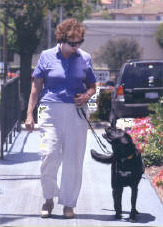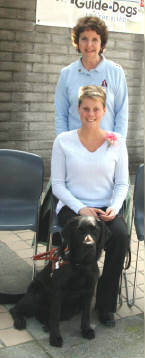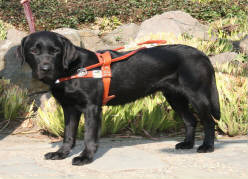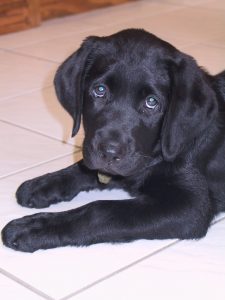Los Angeles Southwest Guide Dog Raisers (LASWGDR) was honored to have reporter Josh Grossberg of The Daily Breeze commit to the assignment of observing and recording the efforts of Leader Pat Whitehead while raising guide dog puppy “Tola.” Josh met with Pat, Tola, and members of LASWGDR in early summer 2005 when Tola was just beginning her training. Josh followed Pat and Tola through to the culminating moment of Tola’s graduation on February 3, 2007.
Read the 3-part series as seen through Josh’s eyes and reported in The Daily Breeze.
July 31, 2005
A vision to help the blind brings a puppy and a South Bay handler together for a “24/7” relationship that will last 18 months
It’s big world out there and it’s filled with all kinds of fun things to do: There’s trash to sniff, bugs to taste and nice people who all seem to want to stop and say hello. Tola positively vibrated with excitement at the endless possibilities.
She was all bright-eyed and loosey-goosey with paws ready to splay out in play as she and a group of puppies visited an Office Depot in Torrance on a spring day, but this wasn’t a pleasure trip. There was work to be done, a destiny to be fulfilled. Tola doesn’t know it, but if all goes according to plan, in less than two years, she will become the eyes for someone who can’t see.
And it’s Pat Whitehead’s job to raise Tola from a rambunctious puppy to a dog mature enough to enter a rigorous five-month training program — college, they call it — at the San Rafael campus for Guide Dogs for the Blind.
The Manhattan Beach resident will do it without once raising her voice and without once raising her hand. With a soft voice and the manner of the world’s most encouraging kindergarten teacher, she’ll do it with gentle tugs of a leash, countless hours of practice and an endless supply of praise.
Except for the whites of her eyes, Tola is jet black from her nose to the tip of her tail. A Labrador retriever, she’s got floppy ears, rolls of extra skin that cascade down her forehead, paws too big for her body and a face that can switch from mournful to mischievous in a heartbeat. It’s almost too much to resist.
“They can be very manipulative,” Whitehead said with a knowing smile.
But no matter what gimmicks Tola pulls out of the puppy bag of tricks along the way, Whitehead will be ready for her. Since 1986, she’s raised 18 puppies to become guide dogs.
“I just have an affinity to animals,” she said. “I’ve always enjoyed it. It doesn’t feel like work.”
Whitehead is the head of L. A. Southwest Guide Dog Raisers, a collection of South Bay residents raising puppies of their own. At the Office Depot, Whitehead spent as much time correcting humans as she did Tola. It’s exacting work and people new to raising puppies can easily give in to a young dog’s charms. The group meets regularly and Whitehead visits members’homes weekly. She also has to fill out detailed reports about how the pups are progressing, which are forwarded to the Northern California headquarters where standards are kept high.
“It’s 24/7 to raise a puppy,” Whitehead said. “You need that consistency.”
Dogs being dogs, they will constantly push the boundaries to see how much trouble they can get into. They quickly learn they won’t have any luck with Whitehead.
“They test to see who the leader is,” she said. “If you let them get away with things, you become an enabler. You have to keep the goal in mind at all times. When they’re little and as cute as can be, it’s fun when they run at you. But at 80 pounds, it’s not so fun.”
The heavy-duty training will come later. Not until they head off to guide dog college will the dogs learn to navigate traffic, stop at obstacles, pull their owners away from danger and acquire the judgment to disobey a command if they think it’s not safe.
But for the first 18 months of their lives, it’s all about becoming well-adjusted, confident and social animals.
“The first year and a half is very important,” said Rick Wilcox, a puppy-raising adviser for Guide Dogs for the Blind. “That’s the time they really learn their basic good house behavior and good public behavior. It’s an invaluable service we could not really do.”
The dogs are bred from parents with strong bodies, alert minds and friendly personalities. Labrador retrievers like Tola are the most popular breed, with German shepherds and golden retrievers right behind. Poodles are starting to be used because they pose less of a problem to people with allergies. The organization places about 800 dogs a year with raisers like Whitehead.
That’s why they were visiting an office supply store. At 12 weeks old, the pups were still too small to explore on their own, so their handlers pushed them around in shopping carts. The sight of eight Lab puppies wearing green vests being wheeled around was enough to grind business to a near halt, with customers and workers stopping to watch and pat them on the head. Whitehead would prefer people didn’t do that, but she knows they will anyway.
Today, Tola is 7 months old and almost full grown at 57 pounds. Since that day at the store, she’s been in malls, offices and restaurants. She even rode a train from Long Beach to downtown Los Angeles, where she and dozens of dogs enjoyed the sights and sounds of Olvera Street. While there, Tola approached a woman wearing long plumes of feathers in her hair and seashells rattling on her sandals. Tola responded perfectly. She wasn’t cowed by the strangeness of the situation, but she didn’t fixate on it either.
She is still playful and tends to jump on people, but on a leash she walks like a champ. She’ll stop for a second to sniff something that catches her attention, but won’t linger. And she keeps as much focus on her surroundings as she does on Whitehead.
Tola is no ordinary pup. Her parents were culled from the finest guide dogs. She was bred to be smart, strong and good natured. It costs about $50,000 to raise and train a guide dog, but ultimate owners don’t have to pay a penny. The organization handles all expenses from the harnesses the dogs wear to the four weeks of training their new owners must go through. Founded in 1942, Guide Dogs for the Blind relies solely on private donations to pay for its services.
More than half the dogs make the final cut to be placed with blind people. The rest have what are called “career changes,” which means they become really great pets. That’s what happens to dogs that are too shy or not up to the rigorous physical standards.
But no matter where they wind up, they are virtually guaranteed a happy life. Guide Dogs for the Blind sees to that. They put possible owners through a screening process and make sure the animals are well cared for and receive adequate medical care.
Even as a child, Whitehead helped train the neighborhood pets and there were always animals in the house, even as she raised two children. Over the years, she and her husband, Ed, have kept guinea pigs, chickens and a tortoise.
“My husband has said no to snakes, so no snakes,” she said.
In the mid-1980s, her two children persuaded her to try her hand at raising a guide dog, even though they already had a dog as a pet. “It was a way to get another dog in the house,” she said.
With a background in educational administration, Whitehead was always well organized. She took to the new task with enthusiasm. The onetime teacher of science and math was now a teacher of sitting and heeling.
The Whitehead house is now filled with barriers; Tola is not allowed to wander around unattended. She’s also not allowed to play fetch because it can increase her hunting drive. But life isn’t all work. Play time is essential and she gets to romp in the yard or play with other dogs regularly.
One of Tola’s friends is Beverly, a blond Lab who shares the same father (Guide dogs are generally named by the organization. Dogs of the same litter all have names that start with the same letter. Tola has brothers named (Tompkins and Tuck). Beverly’s raiser, Gail Hardy of Playa del Rey, comes over regularly for play dates. But even this is monitored. The dogs are not supposed to bite each other.
“They have play time every day,” Hardy said. “You need to release the stress of the day.” Like humans, puppies can become unruly when they reach adolescence. “Ten to 12 months is teen time,” Whitehead said. “They forget everything.”
Whitehead’s house also contains several dog crates for visiting puppies and a variety of stuffed animals and noise-making toys so Tola will learn not to become startled by the new and unexpected.
It’s practice that can have important consequences in the real world. It’s how a dog named Roselle was able to rescue her owner from the World Trade Center on 9-11. Michael Hingson, who has been blind since birth, was at work in the first tower to be hit when it buckled wildly. He didn’t know what happened, but he knew he had to get out. He called for the dog, who was sleeping under his desk, and together they walked down 78 floors.
“She wasn’t exhibiting any sense of fear,” Hingson said. “As firemen started coming up the stairwells, it got more crowded, but Roselle continued to do what I asked her to do.”
They managed to get outside, but Roselle’s skill was only just beginning to be tested. “Going down the stairs wasn’t the hard part,” Hingson recalled. “The hard part was we were 100 yards from the second tower when it fell. It was a deafening roar. Roselle was able to focus through the crowds as we ran. The dust was so thick, we were literally drowning in it, but Roselle was able to continue to guide.”
They ultimately found refuge in a subway entrance. Hingson credits part of Roselle’s calm behavior to the person who raised her.
“Puppy raisers lay the basic foundation for whether we’re going to have a good dog,” he said. “I can’t overemphasize it.”
Most dogs don’t endure such traumatic events. But just getting around town can be a challenge their owners face every day. Stephen McGuire went blind seven years ago during an accident while in the National Guard. Now 32, he relies on his dog, Dara, to navigate around San Antonio where they live. Dogs are a responsibility many blind people choose not to take on, but for McGuire, getting the German shepherd was a choice he’s glad he made.
“I got the handle and told her to go forward,” he said. “I can’t tell you the sense of freedom I felt.” That was four years ago. The two are now inseparable.
“I don’t think we’ve been apart three days’ worth,” he said.
Dara was one of the pups raised by Whitehead. Once she sends her dogs to college, she visits them at graduation. And she often keeps in touch with the new owners.
“I can’t believe how many dogs she’s had graduate,” he said. “The success rate for shepherds isn’t that high. That ought to be telling you something about her training. She’s remarkable and I value her friendship. Dara was the perfect dog when I got her. I gave her all her bad habits.”
Whitehead keeps photo albums of all the dogs she’s raised. And there are pictures of a few of her favorites framed on the wall.
“Each one is so different, but you love them all,” she said.
For every puppy raiser, a time comes to say goodbye. It’s never easy, but they knew long before they ever brought the puppy home that the day would arrive.
“You get very attached to them,” said Wilcox of Guide Dogs for the Blind. “You love them like your own. But you go into this knowing that it isn’t your dog and you’re doing it for someone else. When you put them on that truck to go north, it’s difficult.”
It’s too soon to tell if Tola will make it to guide dog or wind up as a family pet. Whatever the future holds, Whitehead knows that she’s giving the pup as good a chance at making a difference as she can. And she takes pride in knowing about all the dogs she’s helped raise.
“You put a lot of yourself into them, I still get …” her words trailed off. “You say goodbye, but you feel so fulfilled. This dog is going to do her destiny.”
—
Josh Grossberg, reporter
Daily Breeze
310-543-6638
July 30, 2006
Young Lab goes off to dog college
She’s learned the basics. Now she’s ready for college.
Tola, a young Labrador retriever who spent more than a year growing from puppy to adult in the South Bay, is now receiving the last of her training at a Guide Dog for the Blind facility in San Rafael.
Gone is the bouncing ball of fuzz that appeared in a 2005 Daily Breeze article. Now 19 months old, Tola is a sleek, muscular and attentive, if still rambunctious adolescent.
But if all goes according to plan, by the end of the year, Tola will become the eyes for someone who can’t see.
Pat Whitehead, the Manhattan Beach resident who tutored and guided Tola since she was 12 weeks old, dropped her off at the organization’s sprawling Northern California campus earlier this month.
“She’s an exceptional dog,” said Whitehead, who knows a few things about guide dogs. Tola was the 18th dog she has raised for the organization.
The standards for becoming a guide dog are high; just over half the dogs that start the program graduate. If a dog is too shy, cowers at loud noises or shows too much interest in cats, they have what is known as a career change. They can wind up as assistance dogs in other fields or living lazy lives as lucky pets.
So far, Tola has passed one of the toughest challenges at the school: An intensive medical exam that weeds out dogs who aren’t in absolutely perfect physical shape. Her eyes were checked, bones X-rayed, blood tested. So far, so good.
“She’s really responded,” Whitehead said. “She can be silly and right on. She’s right where she needs to be. She’s solid, doesn’t have fear.”
The first part of her life was about becoming a social, well-rounded and obedient dog — the makings of a really great pet. At the Guide Dog campus, Tola will learn things that seem almost impossible for a dog to know: how to navigate in traffic; watch for obstacles; and if she sees a car in a driveway, she’ll stop several feet away if the engine is running or slowly approach it if the engine is off.
She’s going to learn how to obey unfailingly, but also to ignore commands if she decides they’re not safe. Intelligent disobedience, it’s called.

“What we’re looking for is a dog that can focus because guidework is all about focus,” said Joanne Ritter, a spokeswoman with the organization. “We want a dog intelligent enough to make some decisions and also have a willingness to get up and go when needed, but also stay quiet under someone’s office desk or bus seat.”
It costs about $50,000 to raise and train a guide dog, but whoever winds up with Tola won’t pay for any of it. The organization takes care of all expenses, from the harnesses the dogs wear to the month long training their new owners must go through. Since its founding in 1942, Guide Dogs for the Blind has relied on private donations to pay for its services.
For all her poise, Tola is still a young dog. She gets excited when she sees familiar faces and likes to play. But these are qualities that help a dog stand out when it’s time to work.
“You want that verve,” Whitehead said. “You want them to have confidence. You want that silliness.”
Saying goodbye to a dog she has spent virtually every minute with is a bittersweet experience.
“I love her to death,” Whitehead said. “But as much as you love them, she’s not my dog.”
But the Whitehead home wasn’t empty for long. After giving Tola a tearful goodbye hug, Whitehead was introduced to her next project tutor: a 9-week-old puppy named Elsa.
—
Josh Grossberg, reporter
Daily Breeze
310-543-6638
February 08, 2007
Guide dog still remembers South Bay pal
Pat Whitehead greets Tola, the guide dog she raised from a puppy in Manhattan Beach, and meets new owner Courtney Maddocks in San Rafael. Tola helps Courtney Maddocks off a bus at the guide dogs campus and later receives an appreciative kiss.
She knows the difference between left and right and can hop on and off an escalator with ease, navigate through the thickest of traffic and guide her owner through obstacles towering far above her head.
She ignores cats and pays no attention to food, but when Tola set eyes on the woman who raised her, she forgot for an instant that she’s now a focused and highly trained animal serving as the eyes of a blind person.
She was 100 percent pure dog.
As soon as Tola turned the corner at the Guide Dogs for the Blind campus in San Rafael on Friday and saw Pat Whitehead, she leaped for joy. The black Labrador retriever hadn’t seen Whitehead since July, when the Manhattan Beach resident dropped her off for training.
Now fully grown, Tola jumped up, nearly reaching Whitehead’s shoulders, and licked her face happily, her tail wagging uncontrollably. If she had been wearing her harness, such behavior would be a no-no. But since she was on a leash, Tola knew she had the freedom to show how she felt.
As the dog bounced up and down, Whitehead ran her fingers through her thick, black coat.
“Oh, look at you!” Whitehead said. “You’re a real-life guide dog!”
And then, a few minutes later, it was over. Whitehead took a few steps back and Tola quickly calmed down and returned to her position next to her new owner, Courtney Maddocks.
Whitehead was happy when Tola looked not to her, but to her new owner for approval.
“If they don’t bond, they won’t have that relationship that is needed to be a guide dog,” she said. “To be totally blind and have the courage to go out, you have to have that trust.”
As first told in a 2005 Daily Breeze article, Whitehead is the Manhattan Beach resident who had the crucial job of raising Tola from playful puppy to confident and socialized adolescent.
For Whitehead, it was a bittersweet moment. She knows she’s can’t be part of Tola’s life; she just wanted to see her one last time and meet her new owner. And it hasn’t gotten any easier, even though Tola is the 18th guide dog she’s raised (she’s now on No. 19).
Tola graduated Saturday and left for Vancouver, British Columbia, where Maddocks lives.
“Just seeing her with Courtney, just knowing I was part of the beginning, makes it worthwhile,” she said.

Maddocks, who suffers from diabetic retinopathy and lost her sight on her 22nd birthday, is totally blind. For the past several weeks, the 31-year-old woman and Tola have spent day and night together learning to navigate the world. Tola slept by her bed in the facility’s dorm. She sat under the table during meals. And the two have explored vast areas of the Bay Area together.
The entire adventure didn’t cost her a penny; Guide Dogs for the Blind pays for everything, even the transportation to get there.
Although Maddocks has had a previous guide dog, she had to learn to trust a new one to be her eyes in the world. It usually takes about six months for dog and human to form a complete bond.
“It’s an ongoing process,” Maddocks said. “She likes to test me. I have to have control. The first day I was, “Who are you?’ I didn’t have that bond.”
Her other dog, Piper, is 10 now and too old to serve as a reliable guide. She’s living with Maddocks’ parents.
“I didn’t think I could love another dog,” she said. “But I can. She hasn’t failed me yet.”
Only about half the puppies that start the path to become guide dogs make it. Tola, who impressed even her seasoned trainers at the campus, finished the process with ease.
Matching dogs with their new owners is something the staff at Guide Dogs for the Blind takes very seriously.
“We look at their lifestyle, their pace,” said guide dog mobility instructor Ben Cawley. “Some people like an active dog, some a calm one. Some dogs are happy to be a couch potato.”
For Maddocks, finding an active, outgoing dog was of utmost importance. Though blind for less than 10 years, she exudes confidence and embraces life’s adventures. Her hair is cropped short, her eyes bright blue, her smile constant. And when she and Tola walked through a mall in San Rafael, they did it so briskly, they quickly outpaced other shoppers.
“She’s very similar to Courtney,” Cawley said. “She’s a very outgoing individual and very active. Tola fit that.”
The standards for becoming a guide dog are high. If a dog is too shy, cowers at loud noises or shows too much interest in cats, it has what is known as a career change. It can wind up as an assistance dog in other fields or live a luxurious life as a happy pet.
Labrador retrievers make the best guide dogs, although a few other breeds are sometimes used. They are bred on the campus to be in ideal physical shape. Tola’s eyes were checked, bones X-rayed, blood tested. If everything wasn’t perfect, she would not have been given such a weighty responsibility.
That’s not to say Tola isn’t still a goofy dog.
“She’s sweet in nature, but she has a silly side,” Maddocks said. “She likes to run in figure eights and growl when she does it, but in a fun way. She’s a loving, all’s-good kind of dog.”
Maddocks is allergic to dogs, but that will only stop Tola from sleeping in her bed.
“How can you not love them?” she said.
And she said she doesn’t envy those who can see.
“She’s my best friend,” Maddocks said. “I feel sorry for you guys.”
To show her appreciation, Maddocks surprised Whitehead with a cup she bought at the mall. It has a picture of her and Tola on it.
When Tola and Whitehead were saying hi to each other, Maddocks stood quietly next to them. Even though they had talked on the phone, she and Whitehead hadn’t been formally introduced. But after a few seconds, she suddenly burst into tears and began to sob.
She threw her arms around Whitehead and pulled her close. She knew all the work Whitehead had invested in Tola and wanted to show her appreciation.

“Thank you,” she cried. “Thank you so much.” And then, her tail wagging, Tola looked up at Whitehead. And then she looked at Maddocks. Whitehead wiped away her tears and smiled at the dog. “It’s like she’s saying, ‘Job well done,’ ” she said.
Josh Grossberg, reporter
Daily Breeze
310-543-6638

